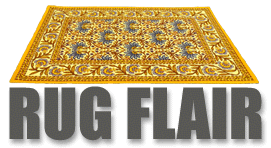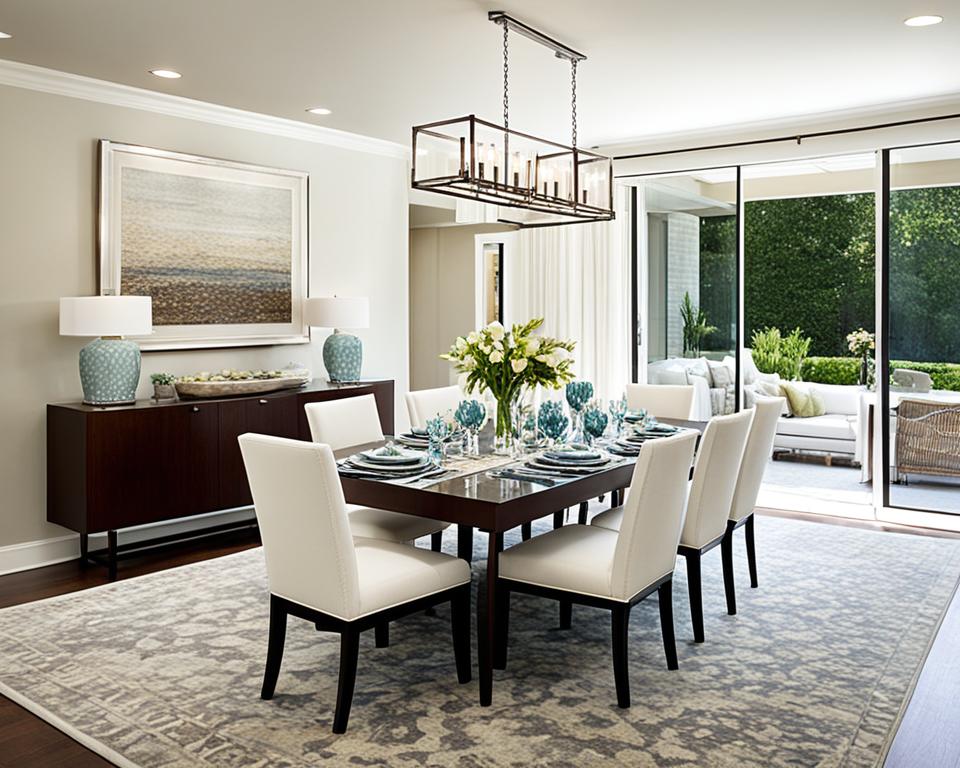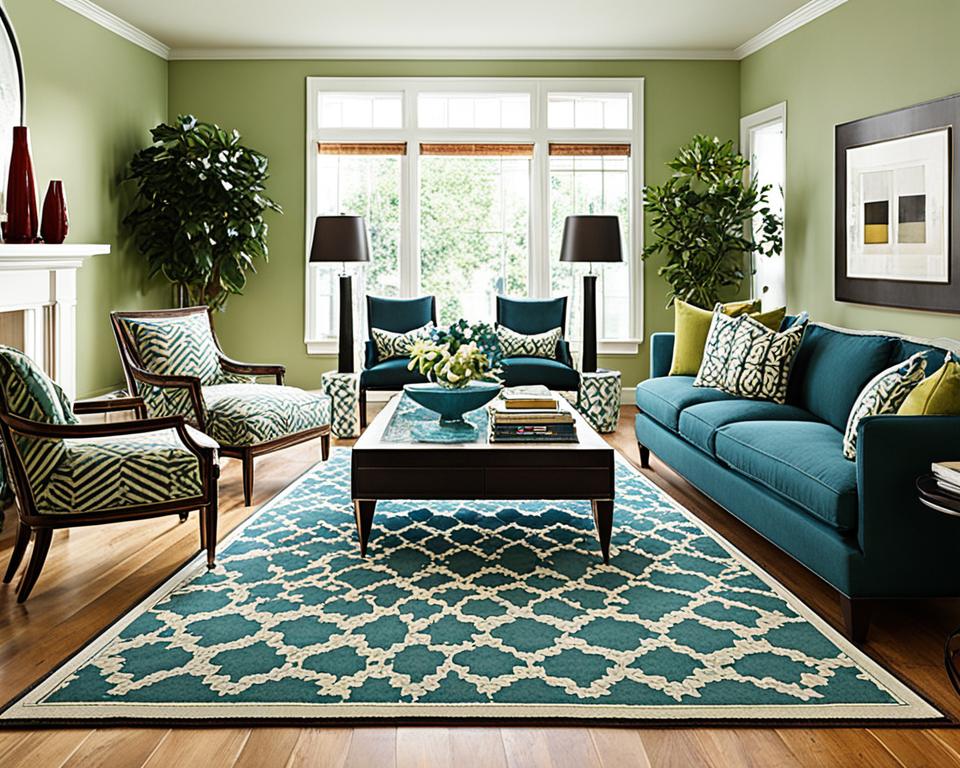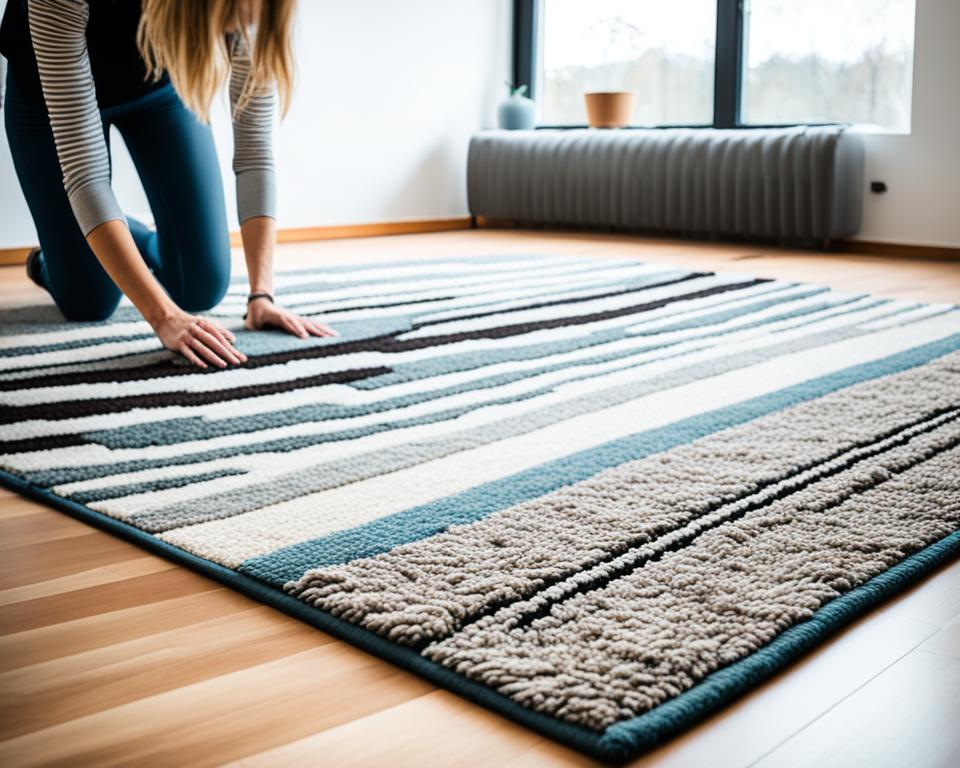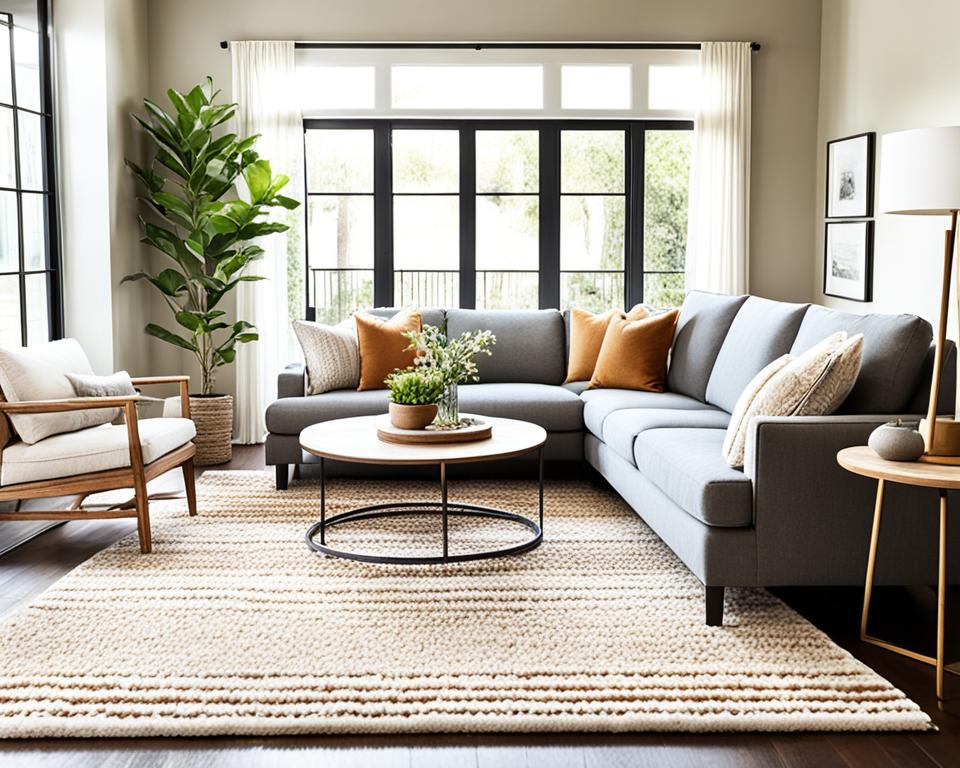Striking the perfect balance in your dining space isn’t just about the right lighting or artwork; it’s also crucial to consider the dining room rug size guide as a foundational element of design. Imagine sitting down to an elegant meal with your loved ones, the chairs gliding effortlessly over a luxuriously sized rug that’s been selected with precision. You don’t want to grapple with a rug that’s too skimpy, leaving guests teetering on the edge – that’s why knowing how much rug under dining table is so important for both comfort and style.
An expertly chosen rug adheres to the suggested area rug dimensions for dining room excellence, embracing your table with generous proportions that prevent your homely space from looking cramped or unfinished. A rug that’s about four feet wider and longer than your dining table not only adds visual appeal but also serves a practical purpose by protecting your flooring and facilitating smooth chair movement.
Key Takeaways
- Adhering to a dining room rug size guide ensures a cohesive look and functionality.
- Choosing the optimal area rug dimensions for the dining room can transform your eating space.
- Consider how much rug under dining table is necessary for aesthetics and chair mobility.
- Avoid the common error of a too-small rug by selecting one that grants a good 24 inches of extra clearance.
- Ensure the rug choice enhances your room’s décor and doesn’t just fade into the background.
- Remember that the perfect-sized rug can protect floors from scratches and make dining a quieter affair.
The Importance of Correct Rug Size in Dining Areas
Selecting the best rug size for your dining area goes beyond mere decoration—it’s a blend of function and style that elevates your dining experience. With the right rug placement under the dining table, you not only safeguard your wooden floors from the scuffs and scrapes of chair movements but also reduce noise levels, contributing to a more intimate and enjoyable atmosphere.
A meticulously chosen rug leads to harmony and balance in your dining space. It becomes an invitation to guests, wrapping the room with warmth and making mealtime conversations cozier. Think of the rug as not just a floor covering, but as an integral part of your dining room’s interior design. Choosing the correct size enhances both the functionality and aesthetic appeal, while improperly sized rugs can disrupt the flow and feel of the room.
| Rug Size | Table Size | Room Size |
|---|---|---|
| 5×8 ft | 3×5 ft | Small to Medium |
| 8×10 ft | 4×6 ft to 4×8 ft | Medium to Large |
| 9×12 ft | 6×8 ft or larger | Large |
As you decide on selecting the best rug size for your dining area, consider the silhouette it casts around your dining table. It’s not just about covering the exact area beneath the table; it’s crucial to include additional space to account for chairs being pulled out. A common rule is to extend the rug 24 inches beyond the table on all sides, ensuring chairs stay on the rug even when moved back.
Remember, choosing a rug with adequate coverage isn’t just about aesthetics; it is about creating a space where memories are made, stories are shared, and laughter echoes—comfortably nestled on a well-placed rug.
- A rug too small can interrupt chair movement and look disproportionate.
- A rug too large can overwhelm the space and make it feel smaller.
- The aim is to strike a perfect balance, one that complements the room’s dimensions and furniture.
How Much Rug Under Dining Table: The Ultimate Guide
Imagine a dining area where every detail has been meticulously planned, down to the thread count of the linens. Doesn’t it make sense to give the same consideration to the rug size for your dining room table? This isn’t just an accessory—it’s a key component that shapes your dining experience. The right area rug not only complements the table’s dimensions but also shelters your flooring and creates an inviting atmosphere. So, let’s delve into the essentials of choosing the right rug size for dining table spaces that cater to both form and function.
Why You Need the Right Amount of Rug
When you consider how much rug under dining table is necessary, think of it as framing a masterpiece. The perfect frame enhances the art, drawing the eye and completing the picture. Similarly, the right rug size anchors your dining set, enhancing its beauty and providing balance to the room’s layout. Avoid the common mistake of choosing a dining table rug that’s too small. It’s a practical choice, too—larger rugs protect your floors and enable the easy sliding of chairs, preventing the dreaded catch-and-tug scenario that can disrupt an otherwise elegant dinner party.
Measuring Your Dining Table
Before you even consider rug patterns or textures, focus on dining table rug measurements. To start, measure your dining table’s length and width. Are there leaves to extend it for special occasions? Include those in your measurements. Now, add 36 to 48 inches to each measurement to ensure that chairs can be pushed back smoothly, without falling off the rug’s edge. Remember, the table is your anchor, and the rug is your harbour—it must be large enough to comfortably contain your dining set, allowing for ease of movement.
Accommodating Dining Chairs
To select the ideal rug size for dining room table arrangements, consider the space needed for chairs to glide back without snagging on the edge of the rug. Aim for at least 24 inches of rug clearance from the table’s edge on all sides, ensuring comfort and preserving the fibers of both the rug and your flooring. This consideration is about more than just the visual—it’s about crafting a user-friendly area that enhances your and your guests’ dining experience. Keep these tips in mind while choosing the right rug size for dining table functionality and flair.
With these guidelines firmly in place, you’re now equipped to elevate your dining area’s elegance and enjoyment. So, go ahead and choose a rug that not only looks amazing but performs impeccably, inviting guests to sit, dine, and delight in your impeccable taste.
Choosing the Right Rug for Your Room’s Aesthetic
When it comes to dining room decor, the importance of selecting a rug cannot be overstated. The right rug can dramatically enhance the style and warmth of your space, making rug placement under the dining table not just a practical choice for protection, but a deliberate choice for style. Finding the perfect rug entails more than browsing colors and patterns; it’s about ensuring it fits your room’s aesthetic and complements your existing decor.
Complementary Styles for Dining Room Rugs
Your dining space reflects your personal style, and the rug you choose should both harmonize with and accentuate that style. With intricate patterns, subdued hues, or bold colors, rugs offer the opportunity to make a silent statement in your dining room. Whether your table is a modern minimalist piece or a family heirloom, the right area rug dimensions for the dining room will frame your dining table perfectly and set the ambiance for the space.
The Aesthetic Impact of Rug Placement
The way a rug is placed can radically alter the look and feel of your room. Consideration of dining table rug measurements is crucial; a rug that is too small will look out of place, while one that’s too large can overwhelm the space. Perfect placement means ensuring the rug is centered under the dining table and extends evenly on all sides, allowing it to act as a beautiful backdrop that pulls the room together. When executed properly, this placement emphasizes your dining area as a focal point, inviting conversation and complimenting your home’s aesthetic.
Determining the Ideal Rug Size for Your Table Shape
Your dining space is an expression of your personal style and functional needs. Selecting the appropriate rug size for your dining room table transcends mere decoration; it is essential for creating a cohesive look and ensuring the comfort of your guests. The shape of your dining table heavily influences the size and form of the rug you need. It’s not just about the coverage area; it’s about symmetry and how it enhances your overall décor.
For those with square or round dining tables, achieving visual harmony is often attained with rugs that match the table’s contours. The parallel lines and consistent diameters led to a sense of balance, underscoring your table as a central piece. Consider this as you shop: a square table pairs elegantly with a square rug, while a round rug underscores the curvature of your round table.
However, when it comes to a rectangular or an oval table, a longer rug that can accommodate the table’s greater dimensions and chair movement is generally preferable. A well-chosen carpet serves to frame your dining area, thereby enhancing the seated experience both visually and practically.
| Table Shape | Recommended Rug Shape | Why It Works |
|---|---|---|
| Square | Square | Mirrors the table’s symmetry and forms a cohesive unit. |
| Round | Round | Continues the table’s circular flow and central focus. |
| Rectangular | Rectangular | Accommodates the table length and allows for comfortable chair movement. |
| Oval | Rectangular or Oval | Reflects the table’s elongated curves and offers even border space. |
By adhering to a comprehensive dining room rug size guide, you can avoid the pitfalls of poorly sized rugs. Remember to allow for additional room around your table, not just for aesthetic reasons but also for practicality. When guests retreat from the table after a delightful meal, the chairs should remain firmly on the rug without any awkwardness or imbalance.
Choosing an area rug that compliments the shape of your dining table enhances the ambiance of your dining room and elevates every meal into a special event.
- Square and round tables look best with rugs of the same shape, enhancing the room’s balance.
- Rectangular and oval tables require larger rugs for proper scale and function.
- The right rug promotes comfort, maintains symmetry, and compliments your dining room’s design.
Making the right choice in rug size for dining room table shapes is not just about adhering to stylistic norms but about creating a dining experience that feels deliberate, comfortable, and visually appealing. With these guidelines, you’re well on your way to a beautifully rugscape that defines and enriches your dining space.
Rug Placement Tips to Enhance Your Dining Experience
Creating a beautiful dining space extends beyond choosing the right dishes and silverware; it’s about crafting an atmosphere that invites warm conversations and memorable meals. The role of a rug in this setting is pivotal, and selecting the best rug size for dining area can mean the difference between a good and a spectacular dining room design. Consider the following guidelines to ensure your rug enhances, rather than detracts from, your dining experience.
Room Size Considerations
When thinking about rug placement under dining table, you must take into account the size of the room. Maintaining a balance between the rug and the room dimensions is key. A recommended boundary of 10 to 16 inches of bare floor between the edges of the rug and the walls gives your room an intentional design and keeps the area from feeling cramped. This means that area rug dimensions for dining room success lie in the details of measuring not just your table, but the room as a whole.
Ensuring Easy Chair Movement
Ease of movement around the dining table is a must for the comfort of your home and the upkeep of your dining set. After all, how much rug under dining table is required for this fluidity? Aim to select a rug that extends at least 24 inches beyond the table’s perimeter. This allowance provides ample room for chairs to be moved in and out without getting caught on the rug’s edge—an absolute necessity for preserving the integrity of both your rug and your floor.
With these placement tips in mind, your next dinner party will be not only a feast for the taste buds but a visual delight as well. Invest in a rug that doesn’t just fit your dining area but also elevates the room to a higher tier of design and comfort.
Understanding Area Rug Dimensions for Your Dining Room
When embarking on the quest to find the perfect rug size for dining room table, it’s essential to delve into the dining room rug size guide to make informed decisions. A rug that harmonizes with the dimensions of your dining table and room not only enhances aesthetics but also enforces functionality. As you ponder over the myriad of choices, keep in mind that standard rug sizes might not always be the best fit for your unique space.
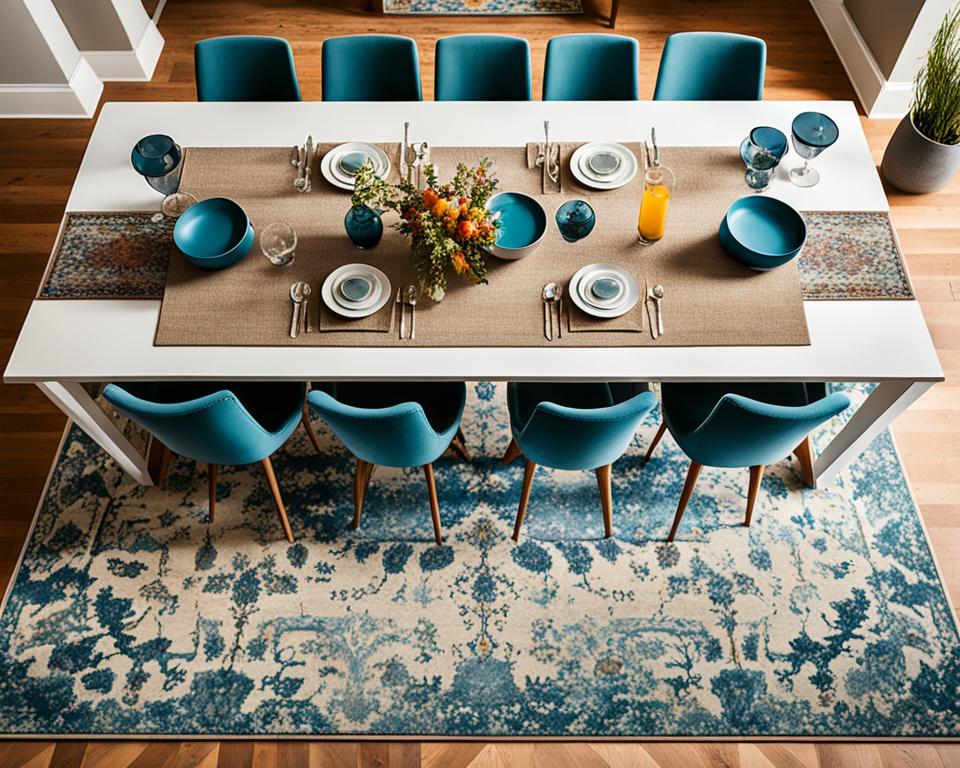
Selecting a rug that’s too small could lead to an awkward dining experience, with chairs wobbling off the edge when guests lean back. Conversely, an overly large rug may swallow the space, making the room appear disproportionately furnished. Therefore, understanding the standard area rug dimensions and when to opt for custom solutions become the hallmark of savvy interior styling.
| Table Size | Recommended Rug Size | Notes |
|---|---|---|
| 2-4 seats | 5×8 ft | Ideal for small dining spaces and compact tables. |
| 4-6 seats | 8×10 ft | Provides ample room for movement and aesthetic proportion. |
| 6 or more seats | 9×12 ft or larger | Accommodates larger gatherings comfortably. |
For those with circular dining setups, don’t round off your considerations at conventional sizes. Rugs with diameters extending from 4 feet to a grand 10 feet cater to an array of table sizes. And if your dining area breaks the mold with its unique dimensions or layout, exploring bespoke rug options can create a tailored atmosphere that’s as visually pleasing as it is functional.
Throughout your decision-making process, keep the goal in sight: to frame your dining ensemble in such a way that it invites, comforts, and complements the rhythm of everyday life.
- Standard rug sizes might not fit the bill for unconventional dining spaces.
- Ensure there is a minimum of 24 inches of rug space around the table on all sides.
- Custom-sized rugs offer a tailored solution for unique spaces.
Arming yourself with this knowledge on the ideal dining room rug size guide will not only enhance the look of your dining area but will also establish a comforting space where meals are savored and memories are made. Next time you shop, regard the rug as the foundation of your dining room’s ambiance, one that should be chosen with as much care as the table itself.
Selecting the Best Rug Size for a Harmonious Look
Embarking on the journey of choosing the right rug size for dining table setups is crucial for achieving a harmonious balance in your dining area. A well-proportioned rug serves as the visual foundation for the space, framing your dining table elegantly and ensuring the ease of chair movement. Let’s explore how to strike that perfect balance between rug size and dining room aesthetics.
Balance and Proportion in Rug Selection
When it comes to selecting the best rug size for dining area, the interplay between balance and proportion cannot be overstated. The secret lies in the alignment of your rug with both the dining set and the room itself, creating a seamless look that also serves the functional needs of the space. An ideally sized rug should allow for the chairs to be comfortably pulled back, while maintaining a pleasing ratio to the dining room area.
Here’s a basic guideline to help you envision the proper rug size:
| Your Dining Table Size | Suggested Rug Size |
|---|---|
| Up to 4 feet (Length) x 3 feet (Width) | 8 feet x 10 feet |
| 6 feet (Length) x 4 feet (Width) | 10 feet x 12 feet |
| 8 feet (Length) x 5 feet (Width) | 12 feet x 15 feet |
Avoiding Common Sizing Mistakes
One of the most common missteps in rug placement is the choice of a rug that’s too small, leading to the awkward situation of dining chairs slipping off the rug. This can be avoided by adhering to a simple rule – the rug should extend between 24 to 30 inches beyond the table on all sides. Such dining table rug measurements prevent chairs from getting caught on the edges and ensure a smooth aesthetic transition from table to floor.
A practical tip before making your final decision is to use painter’s tape to mark the perimeter of the intended rug size on your dining room floor. This visualization allows you to physically see the area the rug will cover and ensure that the rug placement under the dining table will be both functional and inviting.
Being proactive in your rug selection will ensure that your dining space not only looks put-together but also feels intuitively right, welcoming you and your guests to dine in style and comfort.
Maintaining Your Dining Table Rug
Investing in the ideal dining room rug size guide is the first step to enhancing your dining area’s decor and functionality, but maintaining that beautiful look requires some forethought. The longevity of your rug is heavily influenced by the fabrics you choose and your maintenance routine. This section will dive into choosing durable materials that stand the test of time while also giving you practical tips on cleaning and upkeep to ensure your rug remains just as inviting as the day you laid it down.
Choosing Durable Materials
When it comes to selecting a rug based on area rug dimensions for dining room longevity, consider materials known for their durability. Wool and mohair are classic examples, offering surfaces that endure frequent foot traffic and are relatively straightforward to clean. Flat weave rugs are another excellent option, as their lower pile makes maintenance a breeze, ideal for busy dining areas.
However, if you’re drawn to the rustic charm of jute rugs for their organic texture and eco-friendliness, keep in mind they require a gentler hand and sharp eye for immediate spot cleaning, given their higher susceptibility to stains.
Cleaning and Upkeep Best Practices
Post-meal cleanups are a reality of dining room life, making low-pile and easy-care fabrics a practical choice. These materials allow for the quick removal of crumbs and spills, helping your dining space stay pristine. For added convenience, especially for those who entertain often or have young family members, consider washable rugs. They can be swiftly whisked away and laundered, ensuring that no trace of the evening’s festivities remains.
Another ingenious solution? Outdoor rugs. They might seem unconventional at first, but these hardy designs are meant to withstand the elements and can be just as resilient indoors, offering a sturdy yet stylish option for your dining area.
Bear in mind, maintaining the rug size for dining room table doesn’t just preserve the rug’s appearance; regular upkeep also contributes to the health of your family by minimizing dust and allergens. Whether you opt for scheduled professional cleanings or take a DIY approach, consistency is key.
By following these guidelines for choosing materials and keeping up with care and maintenance, your dining table rug will continue to complement your dining experiences for years to come. Remember, when selecting your rug, consider not just the area rug dimensions for dining room aesthetics but also the practicalities of keeping it clean and well-maintained.
Dining Table Rug Measurements: What the Experts Say
When it comes to selecting the best rug size for dining area, it’s not just about your personal taste—it’s also about adhering to certain design principles for a cohesive look and optimal functionality. Experts in interior design have long established guidelines for dining room rug size guide to help ensure that you make the best choice for your space.
Professional Interior Design Metrics
The golden rule in professional interior design metrics for dining table rug measurements is the principle of extension. This rule of thumb suggests that your rug should extend at least 24 inches beyond the dining table in all directions. This way, even when chairs are pulled out, they remain on the rug—preventing trips, slips, and the uncomfortable feeling of sitting unevenly between the rug and the floor.
Here’s a simple yet effective metric for how much rug under dining table is ideal:
| Dining Table Size | Minimum Rug Size | Optimal Rug Size |
|---|---|---|
| Up to 4ft (L) x 3ft (W) | 8ft x 10ft | 9ft x 12ft |
| 6ft (L) x 4ft (W) | 10ft x 12ft | 12ft x 15ft |
| 8ft (L) x 5ft (W) | 12ft x 15ft | Larger or Custom Size |
Ensuring these dimensions allows each guest to be seated and stand up with ease, maintaining the room’s graceful flow. Additionally, these guidelines help protect your floor and the rug itself from wear and tear.
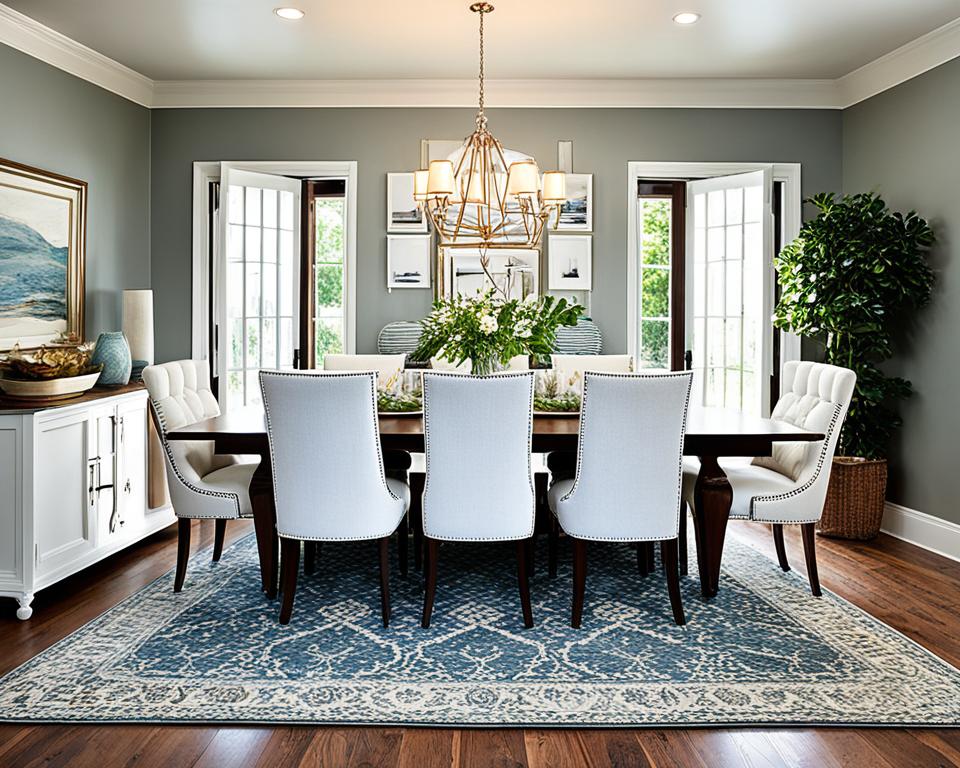
Case Studies: Real-World Examples
Real-world case studies have repeatedly validated the importance of expert-suggested dining table rug measurements. In one exemplar, a standard dining area was transformed into an inviting dining nook by utilizing an 8×10 ft rug, effortlessly accommodating a six-seater table. Guests could maneuver their chairs without snagging the edge of the rug, which not only added to their comfort but also to the room’s overall aesthetic appeal.
In another case, a larger dining space required a 9×12 ft rug, playing up its grandeur while still offering ample space for movement. The placement of this larger rug under the dining table created a stunning focal point, clearly demonstrating the guidelines in practical application.
By applying these real-world insights and expert advice on dining table rug measurements, you can create a dining area that marries beauty with absolute practicality, ensuring every meal is enjoyed in comfort and style.
Incorporating Rugs Into Open Concept Dining Areas
Open-concept homes are known for their seamless flow and unified aesthetic, but without the right design strategies, spaces can appear undefined and lack purpose. The strategic rug placement under dining table can bring definition and break up an expansive room without interrupting its open feel. Not only does a rug add a layer of texture and warmth, but with the ideal area rug dimensions for dining room settings, it also brings an unequivocal sense of intimacy to the dining zone.
Selecting the right rug contributes to both the functionality and aesthetic coherence of a multipurpose space. It allows for creative divisions within an open floor plan, identifying where the dining area begins and where it ends, all while complimenting the surrounding living or kitchen areas. This section will guide you through finding that spot-on rug size and style that makes your dining space feel both distinct and connected within your open-concept home.
- Understanding how rug placement under dining table impacts open-concept living
- Finding the right balance with area rug dimensions for dining room versatility
- Choosing a rug that enhances open-concept dining without overwhelming adjacent spaces
A rug’s dimensions are vital in achieving the ideal delineation of space. Here’s a quick guide to understanding the scale and positioning:
| Dining Area Size | Recommended Rug Size | Visual Benefit |
|---|---|---|
| Small | 5×7 ft or 6×9 ft | Creates a cozy, intimate dining nook |
| Medium | 8×10 ft or 9×12 ft | Defines the area without overpowering nearby spaces |
| Large | 9×12 ft or larger | Anchors the dining area as a central hub within the open space |
Remember, the choice of pattern, color, and texture are just as important as the rug’s size. Opting for hues that complement but don’t clash with the rest of your decor will segue seamlessly into the dining experience. A bold pattern or texture can set the dining area apart without erecting physical barriers, maintaining that cherished open-concept flow.
You have the freedom to express your style distinctly in the dining area while keeping the integrity of your home’s open and airy vibe. The right rug will invite diners in, making the space its own destination within the larger home.
As you finalize your decision on the perfect rug, consider one that’s not only visually appealing but also practical. Easy to clean materials and durability are key for a dining area that sees daily use. The ultimate goal is to select a rug that assures a harmonious look for your open-concept dining that’s both elegant and utilitarian.
Conclusion
As you ponder the essential question of how much rug under dining table to incorporate into your space, it’s clear that the choice isn’t solely about visual pleasure. The right rug size for dining room table serves a multitude of purposes, intricately weaving together practicality with aesthetic finesse. It acts as a shield for your floors, muffles sounds for quieter dining, and ensures a smooth glide for chairs—all while pulling the room’s decor together with a subtle flourish.
Guided by the principles of expert rug placement and sizing, you can deftly select a rug that not only fits the scale of your table and room but also bolsters the ambiance of conviviality and grace. Materials and construction matter as well. By opting for durable, easy-care options, your rug selection becomes an enduring centerpiece of your dining room, inviting interaction and appreciation from all who gather around it.
Ultimately, your discernment in choosing the appropriate rug size for dining room table enhances the environment where meals are enjoyed and memories are cherished. Remember, in your quest to ascertain how much rug under dining table is right for your home, balance proportion with purpose to achieve a space that’s harmoniously elegant and wonderfully practical.
FAQ
What is the ideal rug size for under a dining table?
The ideal rug size extends at least 24 to 30 inches beyond the edges of the table, allowing chairs to slide out without falling off the rug. This typically means the rug should be about 4 feet wider and longer than the dining table itself.
Why is selecting the best rug size for a dining area important?
Choosing the right rug size is crucial because it protects your floor from scratches, reduces noise, frames your dining space elegantly, and ensures chairs can be moved comfortably without tripping over the rug’s edge.
How do you measure your dining table for a rug?
Measure the length and width of your dining table, then add 36 to 48 inches to each dimension to accommodate the chairs when pulled out. Don’t forget to include table leaves if you regularly use them.
How does rug placement under the dining table impact a room’s aesthetics?
A well-placed rug enhances the room’s aesthetics by anchoring the dining area, providing a sense of purpose within the space, and framing the table to create an inviting atmosphere.
How do you determine the ideal rug size for different table shapes?
The rug should mimic the shape of the table – round or square rugs for round or square tables and rectangular rugs for rectangular or oval tables. The rug should also be large enough to accommodate chairs without crowding the space.
What are the room size considerations for rug placement?
For a balanced look, ensure a border of bare floor around the rug, typically between 10 to 16 inches from the rug edge to the room walls, depending on the room’s size.
What are the standard area rug dimensions for dining rooms?
Common sizes include 5×8 feet for small dining tables, 8×10 feet for medium-sized tables, and 9×12 feet or larger for expansive dining areas. For round tables, look for rugs with diameters that complement the table’s size.
What should be considered to maintain balance and proportion in rug selection?
Choose a rug that fits within the confines of your dining set and room, allowing for ample space for chairs and overall visual symmetry. Be mindful of the rug’s scale in relation to the dining area.
How do you avoid common sizing mistakes when choosing a dining table rug?
Before purchasing, use painter’s tape to mark the rug area on your floor or utilize online visualization tools to ensure the size is appropriate, allowing for the necessary clearance around the table.
What materials are recommended for a durable dining table rug?
Wool, mohair, and low-pile synthetic fabrics are durable and easier to clean. Flat weaves are practical, while outdoor rugs can be a durable indoor option as well.
How do you clean and maintain a dining table rug?
Stick to rugs that are labeled as easy-care or washable, vacuum regularly, and promptly address spills. Professional cleaning may be required for deep set-in stains or for high-maintenance materials.
What do experts say about the importance of dining table rug measurements?
Experts recommend that the rug should extend a minimum of 24 inches from the table in all directions, allowing ease of movement and contributing to the aesthetic appeal of the dining space.
How are rugs incorporated into open concept dining areas?
Rugs can define the dining area within an open concept space without obstructing the flow into other areas. The key is to select a rug that complements but clearly delineates the dining zone.
